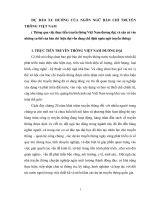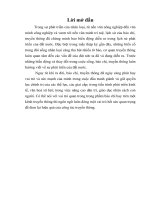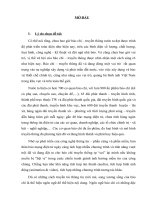Tiểu luận ngôn ngữ và văn hóa
Bạn đang xem bản rút gọn của tài liệu. Xem và tải ngay bản đầy đủ của tài liệu tại đây (78.88 KB, 5 trang )
1
HUE UNIVERSITY
INFORMATICS AND OPEN INSTITUTE
--------------
ASSIGNMENT ON
LANGUAGE AND CULTURE
TOPIC:
MEDICAL DISCOURSE COMMUNITY
Lecturer: Nguyễn Văn Tuấn
Student: Nguyễn Thị Hải Yến
Class: Nghệ An 6
TP Vinh, tháng 8 năm 2023
2
I. Introduction
In the intricate tapestry of the medical field, where knowledge and innovation are
pivotal, the concept of a "medical discourse community" emerges as a vital hub of
interaction, learning, and collaboration. This community embodies a collective of
individuals who share a common passion for medical science, a specialized
lexicon, and a commitment to advancing healthcare practices. As we delve into the
realm of the medical discourse community, we uncover its fundamental
characteristics, roles, benefits, and its profound impact on the broader healthcare
landscape.
A medical discourse community is a dynamic assemblage of healthcare
professionals, researchers, academics, students, and practitioners who engage in a
profound exchange of ideas, knowledge, and expertise. These individuals,
irrespective of their geographical locations, come together through shared goals,
specialized language, and a commitment to unraveling the complexities of
medicine. It is within this community that the boundaries between disciplines blur,
and a vibrant interchange of insights flourishes.
II. Content
1. Language and Terminology
1.1. The Role of Language in the Medical Discourse Community:
Language acts as the lifeblood of the medical discourse community, enabling
healthcare professionals, researchers, and scholars to bridge the chasm between
diverse disciplines and backgrounds. Through the prism of this specialized
language, complex medical concepts are distilled into succinct, precise terms,
fostering a seamless exchange of ideas and insights.
1.2. Precision and Clarity:
In the medical discourse community, precision is paramount. Specialized language
ensures that concepts are articulated with meticulous accuracy, leaving no room for
ambiguity. Be it anatomical descriptions, disease classifications, or treatment
modalities, every term carries a weight of significance, safeguarding against
potential misunderstandings and misinterpretations.
3
1.3. Shared Understanding and Identity:
Medical terminology serves as a unifying force within the discourse community. It
is a unique code that members share, cementing their identity as part of this
specialized realm. The use of medical jargon is not just a matter of semantics; it
signifies membership, expertise, and an unspoken bond that connects professionals
across different corners of the healthcare landscape.
1.4. Gatekeeping and Access:
The intricate terminology of the medical discourse community can also act as a
gatekeeper, distinguishing insiders from outsiders. While this can foster a sense of
exclusivity, it simultaneously underscores the importance of dedicated study and
immersion in the field. Aspiring members must navigate this linguistic labyrinth to
earn their place within the community.
1.5. Language Evolution and Innovation:
Language within the medical discourse community is not static; it evolves
alongside medical advances. New diseases, treatments, and technologies give birth
to novel terms, necessitating a continuous process of learning and adaptation. This
linguistic evolution mirrors the community's dynamic nature and its commitment
to staying at the forefront of medical progress.
1.6. Challenges and Nuances:
While medical language facilitates efficient communication, it can also present
challenges. The density of terminology can overwhelm newcomers, and
miscommunication can arise if assumptions are made about shared understanding.
The delicate balance between technical precision and accessibility must be
maintained to ensure effective knowledge dissemination.
2. Communication Dynamics within the Medical Hierarchy
2.1 Collaboration among Healthcare Professionals
In the intricate tapestry of healthcare, effective communication is the thread that
weaves together the diverse expertise of healthcare professionals. Within the
medical discourse community, collaboration among different healthcare specialists
is not just a convenience but a necessity. The complexities of modern medicine
4
demand a holistic approach that draws on the insights of various professionals, and
effective communication is the glue that binds their efforts.
Consider the bustling environment of a hospital. Nurses, doctors, surgeons,
radiologists, and a myriad of other specialists work in unison to provide
comprehensive patient care. The emergency room, for instance, thrives on
seamless communication among professionals from diverse backgrounds. A
patient's medical history, laboratory results, and imaging studies must be
effectively shared and understood by the entire team to ensure accurate diagnoses
and timely interventions.
A remarkable illustration of interdisciplinary collaboration is the "tumor board"
meeting. In this forum, medical oncologists, surgeons, radiologists, and
pathologists converge to discuss complex cancer cases. Each specialist offers a
unique perspective, contributing to a comprehensive treatment strategy. The ability
to articulate findings clearly, listen actively to colleagues' insights, and collectively
determine the best course of action exemplifies the power of effective
communication in fostering collaboration.
2.2 Teaching and Mentorship in Medical Education
The communication dynamics within the medical discourse community extend
beyond the boundaries of patient care. Education and mentorship are integral
components of this dynamic, facilitating the transfer of knowledge from seasoned
practitioners to the next generation of healthcare professionals. Effective teaching
requires not only expertise but also the ability to convey complex concepts in an
approachable manner.
Medical education is a multifaceted endeavor. A skilled surgeon imparting
knowledge to a resident, for instance, needs not only to demonstrate surgical
techniques but also to explain the underlying principles. This demands clear
articulation and the ability to break down intricate processes into digestible
components. Similarly, mentors guide young researchers through the intricacies of
designing studies, nurturing critical thinking, and scientific inquiry.
2.3 Patient-Provider Communication
The most visible facet of medical communication occurs in the interactions
between healthcare providers and patients. Effective patient-provider
communication is a cornerstone of patient-centered care, transcending the realm of
5
medical knowledge. It encompasses empathy, active listening, and the ability to
translate complex medical concepts into language that patients can understand.
The process of obtaining informed consent for medical procedures is a prime
example of patient-provider communication. In this critical interaction, healthcare
providers must convey the risks, benefits, and alternatives of a procedure clearly
and comprehensively. Effective communication here isn't just about sharing
information; it's about empowering patients to make informed decisions about their
care.
III. Conclusion
In conclusion, communication dynamics within the medical hierarchy form the
tapestry that binds the medical discourse community together. Collaboration
among diverse healthcare professionals ensures comprehensive patient care and
informed decision-making. Mentorship and education forge the link between
generations, transferring knowledge and skills. Patient-provider communication
embodies empathy and transparency, influencing patient experiences and
outcomes. A thorough understanding of these dynamics enhances not only the
quality of healthcare delivery but also the growth and cohesion of the medical
discourse community.
References
1.
2.
3.
4.
5.
Green, M. J., & Myers, K. R. (2010). Graphic medicine: use of comics in
medical education and patient care. BMJ, 340, c863. [DOI: 10.1136/bmj.c863]
Ha, J. F., & Longnecker, N. (2010). Doctor-patient communication: a
review. The Ochsner Journal, 10(1), 38-43. [PMID: 21603463]
Lewis, T., & Elad, S. (2021). Advantages of virtual communication for
medical discourse communities: COVID-19 pandemic perspective. JMIR Medical
Education, 7(2), e29756. [DOI: 10.2196/29756]
Street Jr, R. L., & Gordon, H. S. (2008). Companion to health and medical
geography. John Wiley & Sons. [ISBN: 978-1405189832]
Wray, A., & Medves, J. (2011). A collaborative approach to enhancing
nurse-doctor communication. The Journal of Continuing Education in Nursing,
42(4), 149-154. [DOI: 10.3928/00220124-20101101-04]









